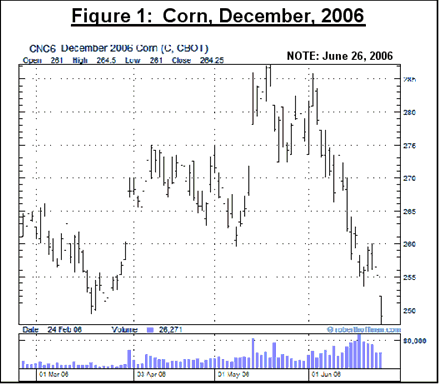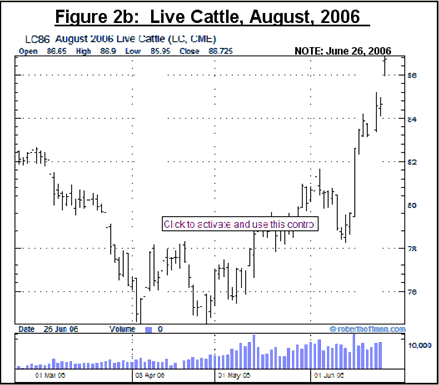AG-ECO NEWS
Vol. 22, Issue 21, June 27, 2006
Jose G. Peña
Extension Economist-Management
Grain Markets Weaken As Cattle Markets Strengthen
Beef Demand Strong, Feeder Supplies Tight And Japan Plans To Reopen Borders
While soybean and grain markets have weakened, cattle markets are showing significant strength. Beef demand is strong, supplies are tight and Japan announced that it plans to re-open its borders to U.S. beef imports by the end of July.
Grains
After showing significant strength in May-to-early-June, futures prices for soybean and corn contracts have weakened as good weather reports improved the production outlook. Price bids for December ‘06 corn futures contracts at the Chicago Board of Trade (CBOT) are provided as an example of recent grain market movement. (See Figure 1).

Cattle
The slaughter of cows continues above a year ago as ranchers continue to thin their herds due to dry weather in a large portion of the U.S., especially in the southwest and western states.
Tight feeder supplies, smaller than expected placements, larger than expected cattle marketings and the potential for increased demand as Japan opens its borders to U.S. beef imports are fueling the cattle market. Price bids for August ‘06 Feeder Cattle (Figure 2a) and Live Cattle (Figure 2b) futures contracts in the Chicago Mercantile Exchange (CME) are provided as examples of recent cattle market movement.

 The cattle inventory is on its second year of expansion, but the rate of increase of the beef cow herd will likely be slower than it would be with normal weather. The size of the cow herd may be up just slightly in the mid-year cattle inventory report, scheduled to be released on July 21, 2006.
The cattle inventory is on its second year of expansion, but the rate of increase of the beef cow herd will likely be slower than it would be with normal weather. The size of the cow herd may be up just slightly in the mid-year cattle inventory report, scheduled to be released on July 21, 2006.In terms of the potential impact of increased beef exports to Japan, U.S. beef producers remain skeptical of Japan’s dependability as a trading partner. Under the current tentative agreement, Japanese auditors must still inspect U.S. processing plants before U.S. imports resume and only boneless beef from cattle 20 months of age or younger will be allowed. The tentative agreement does not provide provisions for the export of bone-in product or for beef from animals 21 months of age or older.
Feedlots Current, Placements Down
According to USDA-NASS, June 22, 2006, Cattle On Feed Report, the total inventory of cattle and calves on feed for slaughter market in the United States for feedlots with capacity of 1,000 or more head on June 1, 2006, totaled 11.187 million head, up 3.9 percent from 10.771 million head on June 1, 2005. Placements in feedlots during May, however, totaled 1.91 million, 14 percent below May 2005 and 19 percent below May 2004. This appears to indicate that while feedlot inventories are current, feedlots may be completing for tight feeder supplies this summer.
Meanwhile red meat production is up, providing consumers adequate supplies at very reasonable prices. According to USDA’s, June 23, 2006, Livestock Slaughter report, commercial red meat production for the United States totaled 4.05 billion pounds in May, up nine percent from the 3.71 billion pounds produced in May 2005. Beef production, at 2.3 billion pounds, was eleven percent above the previous year. The average live weight of cattle slaughter at 1,241 pounds was up 19 pounds from the previous year.
USDA’s June ‘06 estimate of beef production in 2006 at 26.155 billion pounds is up 5.5 percent from 24.784 billion pound produced in 2005. USDA’s June estimate of total red meat and poultry production at 89.694 billion pounds is up 3.4 percent from 86.781 billion pounds produced in 2005.
